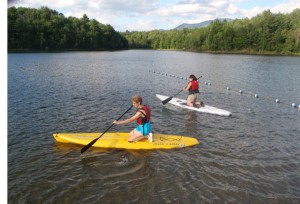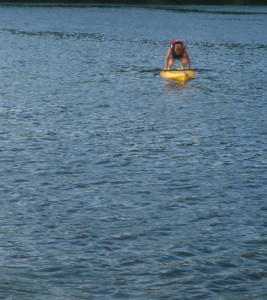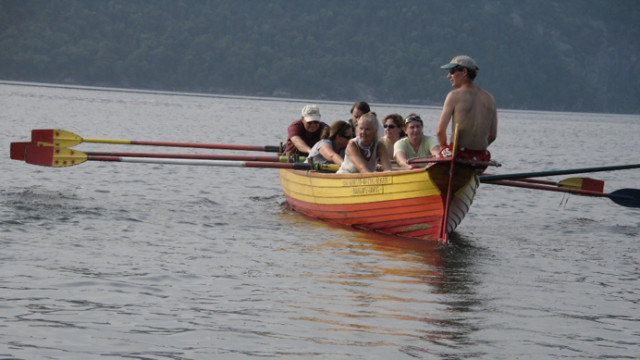Pat and I are adventure junkies, so when I suggested she join me in rowing Longboats at the Lake Champlain Maritime Museum, she was totally game. I’d joined the rowing club earlier in the summer and had a half dozen ‘classes’ under my belt. I promised Pat if she would be my guest I would help her learn the rowing technique in one evening. What I didn’t tell her is how easy it is to row the 32 foot-long boats and I let her squirm a touch with novice anticipation as we drove together to the Museum. The Museum is located six miles west of the town of Vergennes, Vermont, a slim hour from my house.

By 5:30 pm the hot and sticky day was still unpleasantly muggy. Thunderheads threatened. Two of the coxswains were sent to the harbor on foot to assess the weather and returned with a thumbs up. It seemed that an experienced eye was still more reliable than the latest Doppler weather forecast from the web. The assembled 15 or so eager rowers snapped on the requisite life vests and headed for the dock.
Several of the Longboats, also called Pilot Gigs, were tied up awaiting us. They have wonderful names like Wind Rose, Spirit of Otter Creek, and Harvest Moon. The boats are all built by local high school students in a non-traditional school setting. In an intense five month program, eight students work side by side with instructors five days per week learning all the craftmanship required, developing life skills and self-esteem along the way. Ten Longboats constructed in this way are now used for rowing exercise and education in the high schools and for community rowing. That’s how we lucky adults have come to get our hands on the oars.
Pat and I chose the Triton, and carefully stepped in to the center so as not to rock the boat. Four others joined us and we each sat on our own seat, on the side opposite the oarlock. Counting from bow to stern with the bow as number one, I was number two and Pat number three, just in front of me. “Seat number six, the one just in front of the stern is called the stroke,” I explained to Pat. “The stroke sets the rate and rhythm and that keeps us all rowing together.” I could see only the back of Pat’s head as she nodded.
We adjusted the foot stretchers to brace against while rowing and I slipped a foam knee pad purchased from a garden center under my tush. I offered one to Pat. She looked at me quizzically, but quickly got the idea and followed suit. We pulled on gloves to avoid blisters – Pat chose bike gloves and I my leather work ones, and tucked our hips into the gunnel for stability. We were ready!
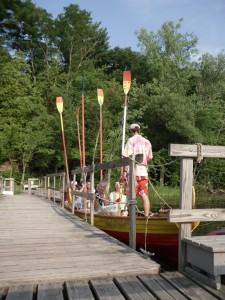
Ben was our coxswain (or cox’n) who steers the boat with lines attached to the rudder and directs the row for the evening. He used a radio to stay in touch with the other boats; they always keep together for safety reasons and an occasional good-spirited racing sprint. Our coxswain helped us untie the Triton from the dock and pull in the fenders. Then he commanded us, “toss the oars!” The 12 to 14- foot oars were laid in the middle of the boat and all hands helped to distribute them because they are long and awkward to handle when not in the oarlocks. Each oar is a slightly different length and numbered; we paired each oar up with the proper rower.
Under Ben’s commands the port side and then the starboard side rowers lowered oars into the oarlocks and we rowed out of the harbor with light strokes. In little time we were on the open lake and took a break to regroup and ready ourselves to row as a team. “Sit ready,” Ben crowed and we all leaned forward, our legs bent for pushing, the oars perched just above the water behind us, our eyes on the stroke. “Ready All,” he said and we gripped the handles tighter. “Row!” And we were off, straining quads against the stretchers, contracting our abs, and flexing arm and shoulder muscles. Whoo hoo!
The Triton began gliding forward, as the oar blades dipped into the lake. We had a few bumbles with the oars until all six of us got the rhythm, but then there was no stopping us! Even though it feels strange at first to row with only one oar, Pat fell into the exercise like she had always done it, just as I knew she would. The sky had grown lighter and the sun was out. It was still hot, but a light breeze made it feel pleasantly cooler. Over gentle waves, we headed almost due west towards The Palisades on the New York side of Lake Champlain where 100 feet of sheer rock cliff looms over the lake – an intriguing destination only viewable from the water or the opposite shore. An awesome evening!
I’ve found the Community Rowing experience on the water to be energizing as well as relaxing. The rhythm of the rowing frees up the mind as the strength building targets the legs and body core too. Every 10 or15 minutes we’d take a break in the rowing to enjoy the scenery and chat with our fellow boaters. Community Rowing takes place weekly from June through September at the Lake Champlain Maritime Museum and a nominal fee gives you membership for the season. Age range from 35 to 70-something.
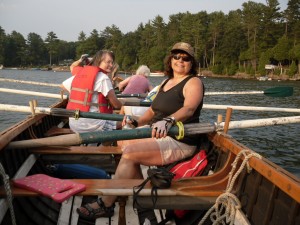
P.S. I discovered that Ozark Longboats of a different style and river tours in them are being revitalized in the Ozark Mountains in Arkansas. That could be fun! Or if you’d like some hiking information about that region, check out this story: Ozark Mountains: The Buffalo River and Hot Springs.
What’s SUP?
Our second venture with paddling came with the new sport of SUP (stand up paddling), practiced on something similar to a surf board. In fact that’s where this sport started–in the Hawaii beach boy community. Anecdote has it that in the 50‘s and 60’s the tourists all wanted their pictures taken while learning to surf and the teachers stood on boards to snap the photos. Sincethere were no waterproof cameras at the time, they progressed to more stable boards. Now this global sport has expanded to flat water paddling, surf paddling, and racing. It is growing strongly in the Northeast. Some places even offer Paddle Board Yoga! Downward dog anyone?
We arrived at Umiak Outdoor Outfitters in Stowe, Vermont to learn about the equipment and what we might be in for before heading down to the Waterbury Reservoir for our lesson. Unlike Pisces Barbara who loves everything that involves getting wet, I was a little afraid that this could feel like “waterboarding” to me. Being a Taurus does have advantages; I’m determined to try anything new and I love anything sensuous. What could be more sensuous than standing on water!
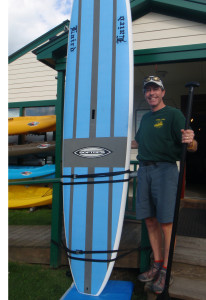
Joe and Craig of Umiak could not have been more enthusiastic or knowledgeable. Joe has just started doing SUP and uses the rental boards from Umiak. Rentals are available at the Waterbury Reservoir; beginner lessons happen there every Thursday from 6-8PM during July and August.
Craig owns a board and often goes out for 3-4 hours at a time. He is in his early 50’s and loves the low impact/high core workout he gets. Craig kept telling us what a great time we were going to have and then asked (more than once) if we had swim suits on. Why did I think we were going to get wet?
The boards are long (10-16 feet), wide (31 inches), and thick (5 inches). They range in price from $700 for a beginner model to $3000 plus for custom boards. A crossover board for flatwater and easy wave riding runs about $1000. And yes, there are women-specific boards. Umiak’s biggest customer base for SUP is women looking to maintain fitness in a cross-over sport. Retirees also are a growing customer base.
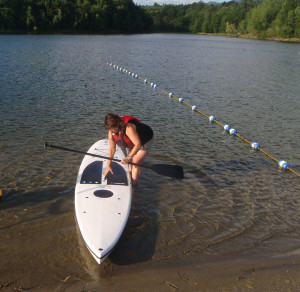
When we arrived at the lesson, Eric assured us how easy it is to learn, and how much fun it is to do. After we were fitted into life jackets, he took our paddles and boards to the shallow water of the Reservoir. Eric encouraged us to stand in the water next to the boards and test their buoyancy before even getting on.
He also explained the basic paddle stroke and had us try it on dry land. Our first in-water attempts progressed from kneeling and hand paddling to kneeling and rowing with the paddles . Then, with his encouragement (from shore) we tried standing up on the boards, staying low to maintain balance.
I don’t think it was more than 20 minutes before we were standing and on our way to farther waters. The first time I paddled consistently without turning around I was surprised at the distance I had covered and just how far away the shore seemed!
Barbara and I paddled for more than an hour, some of the time with Eric alongside talking about form, some of the time alone, some of the time side by side. We got to try two different boards; a small yellow beginner board that would be good to have around for anyone to try, and a cross-over board that was longer and tracked better.
By the end of that hour plus, we were tired. Craig had told us that he often bungees his lunch to the board and has lunch while sitting and drifting, or just rests when he gets tired. We were non-stop boarders and could feel our quads and knees from the constant standing and balancing.
I must say that the most surprising thing was that it WAS easy, and that neither of us even got wet!
